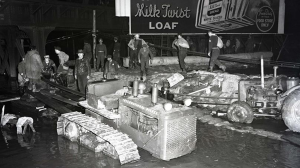The judge found nothing in the bid documents that represented that defendant had assumed the risk of having bidders rely on any supposed assessment it had made. On the contrary, the defendant’s covering letter clearly stated that bidders were to make their own determination of the availability of the necessary building material.
Trial And Appeal Courts Both Reject Contractor’s Action Against Owner And Engineer For Negligent Misrepresentation
by Paul Sandori
JJM Construction Ltd. v. Sandspit Harbour Society
After contract terminated, general contractor suing owner and project engineer claiming negligent misrepresentation in bid documents ? since it was contractor?s responsibility to find sources of material to meet engineers? specifications, and words in bid documents concerning potential sources of stone were nothing more than statement of possibility, representations on rock availability could not be basis for action in negligent misrepresentation ? appeal court agreed with trial court that contractor?s action should be dismissed
The construction of the breakwater for the small craft harbour developed at Sandspit in the Queen Charlotte Islands gave rise to a dispute between the owner (Sandspit Harbour Society), the project engineer (Westmar Consultants Inc.), and the general contractor (JJM Construction Ltd.).
JJM received the tender package from Westmar on August 1, 1995. Bids closed on August 24th. About 80,000 cubic metres of rock were needed to build the breakwater and revetments to Westmar?s design; the specifications called for many gradations of rock. The proposed contract was based on the standard CCDC 4 unit price form.
The bid documents referred to a geotechnical report prepared for Westmar in 1993 by Thurber Engineering Ltd. There was also a reference to a sampling report done on some of the rock in local quarries. What was not made part of the bid documents was another report prepared by Thurber in May of 1995. The earlier geotechnical information was non-committal on the availability of suitable local rock. The May 1995 Thurber report was more negative, and included the statement:
It would be imprudent to assume (suitable material) is available from (either of the local) quarries based on available information.
The bid documents included a disclaimer clause which read, in part, as follows:
The following documents (listed) are bound into the bid documents but will not form part of
the Contract and are not intended as a representation or warranty but are furnished in order that the Bidder may have access to the same information which is available to the Owner. The Owner will not be responsible for any deduction, interpretation or conclusion drawn therefrom by the Bidder…
A letter Westmar sent out with the bid package named two local sources, which shall be called Pit A and Pit B, as ?potential rock sources? but contained the following statement:
Please make your own determination of these and other rock sources that you may wish to consider.
Ultimately, a contract was negotiated. However, neither could not meet the requirements, either in the quality or quantity of stone required by the specifications. JJM had to go find the stone in Alaska.
There was a serious dispute between JJM and the Sandspit Harbour Society. The Society terminated JJM?s contract and another contractor finished the building of the harbour.
JJM sued Sandspit and Westmar claiming that they, in their bid documents, negligently misrepresented to JJM and other bidders that:
??? Westmar had conducted sufficient and proper investigation and had obtained reasonable and proper assurances concerning the ability of suppliers of the rock according to Westmar?s design specifications, and that
??? rock in sufficient quantities and of sufficient quality would be available from the two pits near Sandspit.
Only the main points of the claim focusing on negligent misrepresentation will be addressed in this summary.
At trial, the court found that JJM had bid the job assuming that the required stone was easily obtainable but had not made a full investigation into the proposed sources. Westmar also did not assess the site in order to design the breakwater based on the rock that could be obtained from it.
However, Justice Lowry found nothing in the bid documents that represented that Westmar had assumed, or was prepared to assume, the risk of having bidders rely on any supposed assessment it had made. On the contrary, the covering letter clearly stated that bidders were to make their own determination of the rock sources.
Normally, the supply of materials, labour and equipment is the exclusive purview of the contractor. JJM argued that Westmar ?designed? the rock for the breakwater ? presumably in the way that an engineer designs the aggregate/cement mix for a concrete structure. If that were so, the source of the rock would became a design issue, and Westmar would be open to liability to JJM on the basis of the decision of the Supreme Court of Canada in Edgeworth Construction Ltd. v. N.D. Lea & Associates Ltd.
The trial judge did not accept this argument. Engineers do not design rock. They design the structure and specify the material required to build it. The contractor finds the source or sources from which the material can be obtained to meet the specifications, and at acceptable cost.
JJM further argued that it would be nonsensical for an engineer to design a breakwater without knowing that there was at least one reasonably accessible source of rock available that would meet the specifications.
Generally, responded Justice Lowry, the consultant preparing the bid documents owes a duty to bidders to exercise reasonable care that the information presented reflects with reasonable accuracy the nature of the work so as to enable the contractor to prepare a proper bid. This issue was settled in the 1984 decision of the Ontario High Court in Cardinal Construction Ltd. v. Brockville (City).
The consultant is under no obligation, continued the judge, to determine for the benefit of bidders that the materials required for what is to be constructed are available at a price the bidders might consider acceptable, and there is no implied representation in that regard:
In my view, a case based on a representation about the availability of all the rock to build the breakwater, whether from [Pit A] or elsewhere, does not even get started: there was no such representation.
The trial judge was never put to the exercise of parsing the disclaimer clause because he concluded that JJM had not relied on the geotechnical information in the bid package. Having reviewed a complex fact situation, including a lack of any complaints from JJM until long after the local quarries had failed it, Justice Lowry included the following comments:
…I find that [JJM] did not rely on the tender documents with respect to the gradations of rock the undeveloped quarry could produce and that the 1995 Thurber memorandum would not have had any real effect on it entering into the contract at the price his company did had it been included in the tender package.
Having made this finding, Justice Lowry rendered irrelevant some findings of fact which he had previously made about the basis of Westmar?s estimate for the project and its motivation for not disclosing the Thurber memorandum:
The engineer?s proposal was nonetheless stated to be premised on their assumption ?that a good quality quarry near the harbour site, which could produce competitively priced rock, would be used as the primary source of the material for the breakwater,? although a 15% contingency was said to be built into the estimated cost to cover the ?uncertainty? associated with the lack of an undeveloped quarry.
… Mr. Allyn [of Westmar] says that he decided not to include the 1995 Thurber memorandum in the tender package because it was not, in his view, a reliable document … it was not only left out of the tender documents, but, as indicated, it was not given to the Society with the proposal.
… It should be remembered that Westmar was competing with Hayco for the project and the engineers knew both that the Society wanted to utilize local resources and that there were clear cost restrictions on what could be built. Another explanation for the Thurber memorandum not being disclosed, and one that may be difficult to resist, is that Westmar feared that by releasing the geotechnical opinion they would emphasize an uncertainty that would undermine the competitiveness of their cost estimate, predicated largely as it was on the successful development of a local resource that the Society wished to have used. And, having withheld the 1995 memorandum through the proposal and tendering stages of the project, the engineers may have feared the effect if not the embarrassment of disclosing it in January 1996 when it was evident that much of the rock would have to come from offshore.
JJM appealed to the Court of Appeal of British Columbia. Madam Justice Southin based her decision on the following propositions of law:
(a)??? An owner owes a duty to a builder to take reasonable care in the preparation of bid documents. The bidder is entitled to an accurate and full description of the nature of the work and its factual components. Failure by the owner to disclose that which it knows may be a breach of that duty.
(b) The owner and the engineer both impliedly, if not expressly, warrant in the case of the former, and represent in the case of the latter, that the proposed works are ?buildable.?
So far as the owner is concerned, added the judge, these propositions are subject to whatever disclaimer clauses are in the contract. She further assumed, but did not decide, that availability of specified materials is part of ?buildability,? and that availability contains within it some aspect of affordability.
The trial judge, in his decision, had held that the words in the bid documents concerning potential sources of stone were nothing more than a statement of a possibility. Justice Southin agreed.
With regard to the issue of ?buildability,? the trial judge apparently rejected the proposition that ?buildability? included the availability of specified materials. Justice Southin felt no need to decide whether he was right or wrong because the facts of the case did not require such a determination.
Rock which would meet the specification was available but, apparently, not from a local source. Westmar had taken the specifications for the rock from a publication of a federal Public Works Department. ?One can fairly assume that government departments do not specify the impossible,? commented Justice Southin somewhat optimistically. Furthermore, rock which met the specifications was ultimately obtained but at a substantially greater cost than the contractor had allowed for in its bid.
Justice Southin decided that JJM had failed to demonstrate negligent misrepresentation by Westmar and dismissed JJM?s appeal on this branch of the case. JJM also lost on the remaining issues omitted from this summary.
In her supplementary reasons (addressing the issue of costs), Justice Southin had some sharp comments with regard to what she called ?a very unfortunate extension of the tort of negligence? in the Edgeworth decision:
Shortly put, my point is that the Legislature ought to enact that architects and engineers owe no duty of care in tort to persons other than their clients, and owners letting contracts for the construction of works owe no duty of
care either to the general contractor or the subcontractor. I am speaking only of a duty
of care as a foundation for an action of negligent misstatement causing economic loss. To put it another way, the Legislature should override the decision in Edgeworth Construction Ltd. v. N.D. Lea & Associates Ltd?
It would also be a good thing if the Legislature disposed of the doctrine of concurrent liability in contract and tort.
The amount claimed by JJM was approximately $5,000,000. After a trial of 44 days, JJM failed completely.
Westmar paid legal bills of $734,985; part of that was disbursements. The legal bill of the owner was $486,000 for fees and approximately $88,000 for disbursements. The contractor?s legal bill was $685,000, possibly not including disbursements.
But it is not only the parties who pay, continued the judge. Much judicial time was expended before the action ever reached trial. Judicial stipends, incidental allowances, and ultimately pensions, come out of the federal treasury. From the provincial treasury comes the cost of the support staff and the maintenance of the court buildings.
By contrast, Justice Southin estimated that if the only cause of action open to JJM had been based on its contract with Sandspit, the trial might have taken ten days instead of 44. Westmar, which had no contract with JJM, would not have incurred any legal bills defending itself against the contractor (although Sandspit might have brought some sort of third party proceedings against it). The costs for the owner and contractor would have been only a quarter of the actual amounts.
Court of Appeal for British Columbia
Southin, Hall and Mackenzie JJ.A.
November 4, 1999
Supplementary Judgment: January 31, 2000










Recent Comments
comments for this post are closed